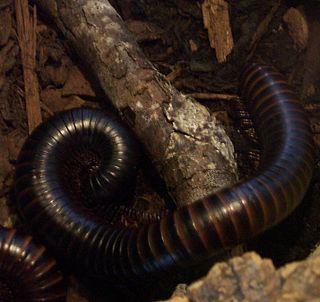
Lithobius is a large genus of centipedes in the family Lithobiidae, commonly called stone centipedes, common centipedes or brown centipedes.

The Machilidae are a family of insects belonging to the order Archaeognatha. There are around 250 described species worldwide. These insects are wingless, elongated and more or less cylindrical with a distinctive humped thorax and covered with tiny, close-fitting scales. The colour is usually grey or brown, sometimes intricately patterned. There are three "tails" at the rear of the abdomen: two cerci and a long central epiproct. They have large compound eyes, often meeting at a central point. They resemble the silverfish and the firebrat, which are from a different order, Zygentoma.
Japyx is a genus of diplurans belonging to the family Japygidae. These eyeless, predatory hexapods largely shun direct sunlight, remaining under stones and among detritus, where they use pincer-like cerci to catch their tiny prey.

Trichoniscidae are a family of isopods (woodlice), including the most abundant British woodlouse, Trichoniscus pusillus. Most species of woodlice that have returned to an aquatic or amphibian way of life belong to this family. Several species from the following genera live in water and on land: Titanethes, Cyphonetes, Alpioniscus, Scotoniscus, Bureschia, Brackenridgia, Mexiconiscus, Trichoniscoides, Cretoniscellus, Balearonethes and Cyphoniscellus.

Polydesmida is the largest order of millipedes, containing approximately 3,500 species, including all the millipedes reported to produce hydrogen cyanide (HCN). Polydesmids grow and develop through a series of moults, adding segments until they reach a fixed number in the adult stage, which is usually the same for a given sex in a given species, at which point the moulting and the addition of segments and legs stop. This mode of development, known as teloanamorphosis, distinguishes this order from most other orders of millipedes, which usually continue to moult as adults, developing through either euanamorphosis or hemianamorphosis.
Metajapyx is a genus of forcepstails in the family Japygidae. There are more than 30 described species in Metajapyx.

Spirostreptus is a genus of giant millipedes of the family Spirostreptidae. It contains the following species:

Julidae is a family of millipedes in the order Julida, containing more than 600 species in around 20 genera. Its members are largely confined to the Western Palaearctic, with only a few species extending into the Oriental and Afrotropical realms. They are united by a characteristic form of the mouthparts, and are classified in the superfamily Juloidea of the order Julida, alongside the families Trichoblaniulidae, Rhopaloiulidae and Trichonemasomatidae.

Polyxenidae is a family of millipedes in the order Polyxenida containing approximately 47 species in 19 genera. Adults in all species in this family have 13 pairs of legs.

Chordeumatida is a large order of millipedes containing some 1200 species with a nearly worldwide distribution. Also known as sausage millipedes, they grow and develop through a series of moults, adding segments until they reach a fixed number in the adult stage, which is usually the same for a given sex in a given species, at which point the moulting and the addition of segments and legs stop. This mode of development, known as teloanamorphosis, distinguishes this order from most other orders of millipedes, which usually continue to moult as adults, developing through either euanamorphosis or hemianamorphosis.
Siphonophoridae is a family of millipedes in the order Siphonophorida. There are about 12 genera and more than 110 described species in Siphonophoridae.

Andrognathidae is a family of millipede in the order Platydesmida. There are about 17 genera and more than 30 described species in Andrognathidae.
Anethoporus is a genus of spirostreptid millipedes native to northern South America, where they range from Peru to the islands of Trinidad and Tobago. The genus and type species, A. clarki, was established by Ralph V. Chamberlin in 1918.

Geophilus is a large, heterogeneous genus of soil centipedes in the family Geophilidae largely considered to be synonymous with Brachygeophilus. It is a mostly holarctic genus characterized by a claw-shaped ultimate pretarsus, anterior porefields, complete or nearly complete coxo-pleural sutures at the prosternum, and incomplete chitin-lines. Centipedes in this genus range from 1 cm to 8 cm in length. The generic name first appeared in Brewster's Edinburgh Encyclopaedia in 1814 as Geophilus electricus.

Cylisticus is a genus of woodlice in the family Cylisticidae. There are at least 70 described species in Cylisticus.

Ophyiulus is a genus of millipedes in the family Julidae. There are more than 30 described species in Ophyiulus.

Trigoniulus is a genus of millipede in the family Trigoniulidae. There are at least 90 described species in Trigoniulus.

Cryptops sometimes known as cave centipedes, is a centipede genus in the family Cryptopidae; species records have a world-wide distribution.

Otostigmus is a genus of centipedes in the family Scolopendridae. It was first described by Swedish naturalist Carl Oscar von Porat in 1876. The genus as a whole comprises around 157 species, found primarily in the Neotropics.

Otostigminae is a large subfamily of centipedes, containing nearly half of all species in the family Scolopendridae. Members of this subfamily are abundant and widespread throughout the tropical and subtropical regions of the world, mostly in Africa, Asia, and Australia.















